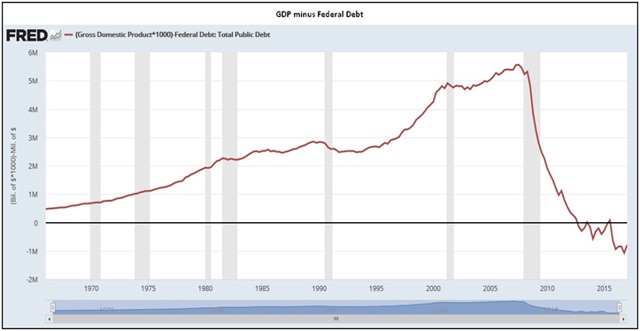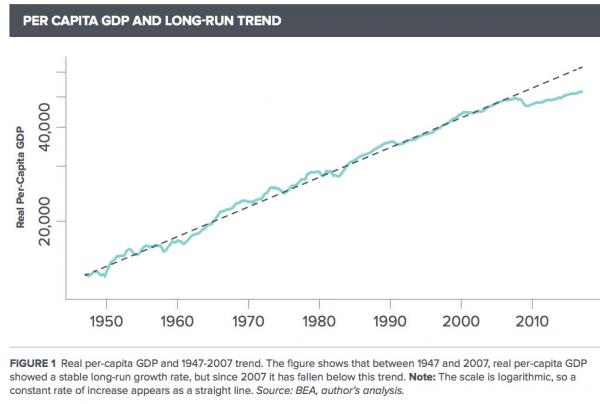by David Haggith

While David Stockman stated early this year with resolute certainty that the debt ceiling debate would blow congress up and send the nation reeling over the financial precipice, I avoided jumping on the debt-ceiling bandwagon. While I was convinced major rifts in the economy would start to show up in the summer, I was not convinced they would have anything to do with the debt ceiling debate. If there is anything you can be certain of this in endless recovery-mode economy, it is that the US will just keep pushing its bags of bonds up a hill until it can finally push no more. So, I figured another punt down the road was more likely.
The Debt Ceiling Debate that Didn’t Happen
The reason I didn’t think that debate would blow apart is that Republicans have more than once experienced the political reality that comes from taking the nation to the brink of default or of shutting down government. Each time that kind of thing has happened, it has hurt Republicans far more than it has hurt Democrats. I doubted establishment Repubs (the majority) had the stomach to take us through another credit downgrade, though I’ve noted such an event was possible.
Unsurprisingly to me, then, Congress did the only thing it seems to be capable of any more and just kicked that can a little further down the road with hardly a kerfuffle about it. Hurricane Harvey made things a lot easier for congress to kick the can again by providing a good excuse to dodge that unwanted debate on the basis of massive human suffering that truly did need tending to. Much-talked-about government shutdown put off for a better time
The debate was entirely avoided even as the national debt broke over the $20 trillion mark this summer, keeping US debt at more than 100% of GDP, which is the stratosphere we’ve been in since 2011.
A group of progressive economists affiliated with the University of Massachusetts predicted in 2013 that a debt burden [that reaches 90% of GDP for five years] would result in an annual growth rate of just 2.2 percent, which means economic stagnation. (Reason.com)
We’re already well past that five-year marker. Not surprisiing, then, that the Congressional Budgeting Office expects economic growth to stay at 1.8% through 2027.
George Will observed that the difference between 2 percent annual growth and 3 percent annual growth is the difference between a positive, forward-looking country in which politics recede from everyday life and a Hobbesian nightmare in which interest groups slug it out over a barely growing pie. Note that he was talking about 2 percent annual growth, which seems positively aspirational in the 21st century. (Reason.com)
Nation caught in a debt trap
The biggest (or most likely threat) from the national debt is what economists refer to as a debt trap. The nation can be considered caught in a debt trap if the Federal Reserve loses the ability to raise interest because the rise in interest would immediately drown the economy or cause the nation to default on its debt. So long as interest rates are low, the US government can afford its huge debt; however, we are now at a point where, if interest rates rise to historically normal levels, we’re in big trouble. That means we are in, at least, enough of a debt trap that interest rates can never be allowed to normalize.
Several debt traps are shaping up besides the one formed from government debt. One is the corporate debt trap, where corporations have kept earnings per share high by taking out huge piles of debt year after year to buy back shares. If businesses have to refinance all this debt at a higher interest rate, they could be in big trouble. We hear over and over that today’s high stock valuations are justified by the fact that earnings keep growing; but it is not top-line revenue that is growing, it is earnings per share, and most of that “growth” is due to corporations taking out debt in order to buy back shares and thus reduce the number of shares over which those earnings are divided. If interest rises, corporations will no longer be able to afford to buy back shares on debt, and that support for the market will crash. They might not even be able to afford to pay off the debt they have already taken on. So, there is another reason the Fed can never allow interest to normalize by historic standards.
 Yet another debt trap now exists in personal credit where many households have reached peak debt. Household debt maxed out this summer above the level it had hit at the peak of the 2007 credit bubble — one more of those big signs of trouble in the economy that I said we could anticipate seeing by the time summer rolled around.
Yet another debt trap now exists in personal credit where many households have reached peak debt. Household debt maxed out this summer above the level it had hit at the peak of the 2007 credit bubble — one more of those big signs of trouble in the economy that I said we could anticipate seeing by the time summer rolled around.
Income, in the meantime, has not improved in order to support this higher level of debt, now at a level that already proved unsupportable in the past. That puts the US back in the unstable position where households that already carry all the debt they can afford can be suddenly sunk if they have any variable-interest credit cards or an adjustable-rate mortgage. That is yet another reason the Fed can never allow interest rates to normalize.
Harvard economist Kenneth Rogoff warns that a sudden spike in interest rates is the biggest threat to the global economy…. People have got used to ultra-low interest rates…. “If something was to happen that pushes interest rates up, we could see a lot of soft spots — places where there is high debt — start to unravel,” Rogoff said. (NewsMax)
It should be no surprise, then, that the number of credit-card accounts moving into delinquency swung upward for the third consecutive quarter this summer, a nine-month trend not seen since the bottom of the 2009 crisis. Yet another summertime crack in the economy — one that is not large yet but will become large quickly if the Fed allows interest to move upward any more than it already has.
In short, the national economy is riddled with high debt everywhere, which leaves every area of the economy with little wiggle room. So, the one certain thing about the huge piles of debt that have built up in the last few years is that we have reached the point where they are actually starting to box the Fed in to where raising interest to combat inflation will not be possible because it will cause damage throughout the economy. The tide has already closed in around the Fed to where it can no longer move to normalize interest in any direction without going deeper into rising waters.
S&P’s chief economist, Beth Ann Bovino, wrote recently that “failure to raise the debt limit would likely be more catastrophic to the economy than the 2008 failure of Lehman Brothers and would erase any of the gains of the subsequent recovery.”
The Great Recession is still with us
If you want to get a sense of how the debt trap affects the nation’s real net worth, consider what the total gross domestic product of the United States looks like if you subtract all that debt that we’ve added each year in order to create that product:

Note: Federal Reserve Economic Data sheets express GDP in billions while Federal Debt is expressed in millions, so in this chart they multiply their data numbers for GDP by 1,000 in order to express both in terms of the number of millions (there being a thousand millions in every billion).
That is essentially the debt trap in a snapshot. And that’s just subtracting the federal debt from GDP. What would it look like if we subtracted out all the business debt that was piled up in the creation of our total domestic product and all the personal debt? You can see the picture looked positive right up until the Great Recession hit, and it has deteriorated precipitously ever since.
Based on this picture we have remained in a huge depression since the financial crisis. I have been saying all along that we are still in the Great Recession, which is why I called this blog The Great Recession Blog. The Great Recession still defines our present economy. We never exited; we just propped the economy up (created positive GDP) with mountains of debt (federal and corporate) so that we cannot feel how deep that depression really is; but the debt trap will suck us into this abyss as soon we can no longer sustain the creation of that debt. We have not powered out, as the Fed planned. If we had, GDP would be growing faster than debt.
We are essentially at that point of stark realization now as the Federal Reserve reduces its reinvestment in government debt (bonds) this month. (A process slated to start slow but to become huge by the end of 2018.) Until now, when a government bond matured during this past decade of Fed stimulus so that the government became responsible for repaying the bond principle to the Fed, the government just issued another bond, and the Fed bought that. The new issuance gave the government the money it needed to pay off the first bond. Now that the Fed is backing away from buying new government bonds (starting to divest), the government will be forced to find other financiers.
That will most likely raise the interest the US government has to pay in order to attract new buyers of its bonds, making the national debt less and less sustainable. What happens, then, to GDP as the government finds it harder to maintain its huge deficit spending that is propping up GDP (because the things government buys with that debt have always been included in GDP calculations)?
This unwinding scenario, of course, depends on what happens in the rest of the world because the US doesnt finance all of its debt internally. If Europe, for example, starts to collapse ahead of the US (as it now contemplates its own unwind), the US could once again prove to be the best looking horse in the glue factory and, so, still find ready foreign buyers at low interest for bonds that have to be issued to someone other than the Fed now that the Fed (the buyer of last resort) is backing away from repurchasing. That could purchase the US yet, again, a little more time. (That could just as easily swing the other way, of course, with the US collapsing first, sending money fleeing to Europe.)
Another way to look at our present situation since the Great Recession began — in order to see that its new economy stays with us — can be seen in this chart:

The trend line in GDP per capita (with government deficit spending still included in the calculation of GDP) broke off at the start of the Great Reession, and it clearly never recovered. It relentlessly sputters along at a decreased rate of growth. Moreover, it has only been maintained at that much lower trend because of the massive amounts of government debt and Fed stimulus. So, what happens to the new trend line when when that money is withdrawn from the economy and interest is allowed to rise?
The bags full of bonds we are pushing up the hill will become significantly heavier if interest rises and will exhaust us, and the present change in Fed repurchasing is a big enough change to tip that balance (given that the amount on the balance sheet the Fed is planning to now unwind is equal to more than 20% of GDP). That is why Jamie Dimon of JPMorgan Chase warned that we’ve never seen anything on the scale of what is about to happen and had better be careful.
One essential truth underlying this blog has always been that you cannot dig your way out of a debt-based financial crash by digging the debt trap deeper and deeper. I called this The Great Recession Blogbecause I believe the most fundamental truth about our current economy is that we are still in the Great Recession. It broke us for good in that we have not recovered from that event even with massive amounts of stimulus (beyond anything the world has ever attempted). GDP looks marginally acceptable but only on the surface and is clearly continuously now on a lower trend. Underneath it all is a yawning pit of debt, more than capable of swallowing our entire economy.
![By James Montgomery Flagg. (Cartoon by James Montgomery Flagg, via [1]) [Public domain], via Wikimedia Commons](http://thegreatrecession.info/blog/wp-content/uploads/UncleSamWithEmptyTreasury-265x300.jpg)